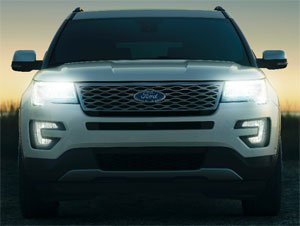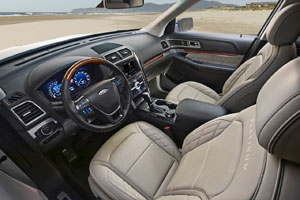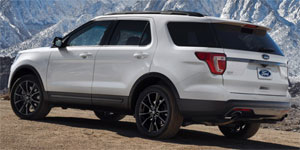2017 Ford Explorer
Since it first arrived for 1991, the Ford Explorer has been a top seller among larger SUV’s and crossovers, with over 7 million sales to date. But, the market for three-row family utilities is bigger and more cut-throat than ever. So, the latest Explorer is outfitted with lot of little changes that Ford hopes will bring big results, with less exploring and more conquering.
2016 marked the 25th anniversary for the Ford Explorer. And while it was far from the first SUV, it was clearly one of the first that made a case for being a family vehicle more than just a rutted roads runabout.
Today’s Explorer bears little resemblance to that truck-based original, now riding on a three row crossover platform that debuted for 2011. Styling updates for ’16 included more than just the usual front fascia; as hood, headlamps, and fenders were new as well.
Most everything got freshened in back also; lift gate, bumper, and taillights. And of course there’s some new wheel styles to choose from. 20-17 adds a Sports Appearance Package with 20-inch wheels and Magnetic Grey highlights for the XLT trim.
 A straightforward 3.5-liter naturally-aspirated V6 is still the base engine. More entertaining is this twin-turbo EcoBoost 3.5-liter V6 with 365-horsepower and 350 lb-ft. of torque.
A straightforward 3.5-liter naturally-aspirated V6 is still the base engine. More entertaining is this twin-turbo EcoBoost 3.5-liter V6 with 365-horsepower and 350 lb-ft. of torque.
The newest option, is the Mustang’s 280-horsepower 2.3-liter I4 EcoBoost that replaces the 2.0-liter.
If your budget is not restricted, by all means opt for the 3.5 EcoBoost. It makes the Explorer feel like a true performance-style SUV. Though all engines offer adequate power as well as all-wheel-drive; and come equipped with a 6-speed automatic transmission. Max towing is a class-norm 5,000-lbs.
The all-wheel-drive system features Ford’s Terrain Management System with settings for Normal, Snow, Sand, and Mud. In our experience, you pick your road conditions and the Explorer responds.
Now, there seems to be no limit to how far manufacturers will go to add poshness to utilities, nor buyers’ appetites for same. So, Ford brings the Platinum series to the Explorer. It features real wood and aluminum trim, as well as premium Sony sound and quilted leather.
And it’s altogether very nice, almost Land rover spec. inside. The brushed aluminum accents are gorgeous, and the animal hides are Nirvana leather, but think more of the place you want to spend eternity in, not the alternative rock band playing right now on Lithium.
 7–passenger seating is standard, with 2nd row Captain’s chairs, an option.
7–passenger seating is standard, with 2nd row Captain’s chairs, an option.
Being one of the larger 3-row crossovers means that cargo space fairs well at 21.0 cubic-ft. behind the 3rd row, 43.9 behind the 2nd row, and maxing out at 81.7 cubic-ft. A hands free lift gate is available with XLT and Sport trim; standard on Limited and Platinum.
Platinum trim also includes enhanced Active Park Assist; and on the safety front, inflatable 2nd row safety belts are now available on all models.
As before, the Explorer won’t yet apply the brakes for you if a collision is imminent; but it will give plenty of warning, and provide full braking pressure once you initiate the stop.
Turbocharging may not me a total replacement for displacement, but our twin-turbo V6 felt plenty V8-strong at our test track. There’s good torque down low, and grippy all-wheel-drive hookup, for a 6.5-second sprint to 60.
There was plenty of high-end grunt as well, accompanied by urgent shifting from the 6-speed automatic; taking us to the end of the ¼-mile in 15.0-seconds flat, at 94 miles-per-hour.
Through the cones, the Explorer still feels big and heavy compared to its many more nimble rivals. But there are still plenty of people out there who want their Bronco-type vehicle to still feel like a truck.
 It’s certainly manageable, though. Just keep the speeds down and your inputs smooth.
It’s certainly manageable, though. Just keep the speeds down and your inputs smooth.
Despite that big-truck feel, a 121-foot average stopping distance from 60 is quite good for any family-size utility. Nose dive was moderate, with pedal travel on the long side.
Government Fuel Economy Ratings for the EcoBoost V6 with all-wheel-drive are 16-City, 22-Highway, and 18-Combined. Our average with Regular grade was right on, at 18.1 miles-per-gallon. That makes for a poor Energy Impact Score at 18.3-barrels of yearly oil consumption with 8.2-tons of CO2 emissions.
There’s a wide variety in pricing, as you might expect, starting at $32,105 for a base 2017 Explorer; all-wheel-drive adds $2,150 more. While Platinum trim comes with a tag befitting the name, at $54,180
Even after a quarter of a century, Ford has managed to find ways to significantly improve the Explorer without any turnoffs. The luxury intentions of the Platinum are obvious, while the rest of the lineup still plays the large family vehicle part perfectly. We think that will keep Explorer’s market-conquering ways intact beyond the horizon.
Specifications
- Engine: 3.5 liter
- Horsepower: 365
- Torque: 350 lb-ft.
- 0-60 mph: 6.5 seconds
- 1/4 mile: 15.0 seconds @ 94 mph
- EPA: 16 mpg city / 22 mpg highway,
- Energy Impact: 18.3 barrels of oil/yr
- CO2 Emissions: 8.2 tons/yr
2024 Polestar 2
More Range And More Power For The Polestar 2
Volvo is well on their way to making the transition to an all-electric brand, but their sister-brand Polestar is already there. Now, we’ve spent lots of time in their all-wheel drive, five-door Polestar 2, having tested it in 2021, and a year later when a two-wheel drive version arrived. But, EV updates are coming quickly. So, let us be your guide for all that’s new with the Polestar 2.
While we are driving more EVs than ever, we’ve also been spending a lot of time recently circling back to ones we’ve previously tested. As in this new era of electrified vehicles, significant updates are arriving quickly, with R&D investments increasing and retrofitting them easier than ever. This is often done through software updates that can even be accomplished over the air. For 2024, the Polestar 2 has indeed gotten some software updates, but some physical ones as well.
Clearly aimed directly at Tesla’s Model 3 when it arrived; the Polestar 2’s build quality was vastly better, but range definitely came up short. So, addressing that was priority No. 1; and for ’24 the Polestar can travel up to 20% farther than before while consuming 9% less energy, and when it comes time to charge it back up, it can do that 34% faster too.
Range in the Single Motor version increases from a max of 270 to 320 miles thanks to a larger 82-kWh battery pack, and that solitary motor now powers the rear wheels, not the front wheels. It’s also bigger, coming in at 220 kW compared to the previous 170 kW front-wheel drive version, going from 231 to 299 horsepower.
Dual Motors keep the same 78-kWh battery, but still sees a boost from 260 to 276 miles and takes advantage of the larger rear motor for a new combined 310-kW output with 421 horsepower. Our test car has the added Performance Pack, which uses an additional 35 kW to deliver 455 horsepower and 546 lb-ft of torque, though max range drops to just 247 miles.
The new battery in rear-drive 2s will also charge faster, now accepting up to 205 kW for an 80% charge in 20 minutes; max for dual-motors stays at 155 kW, which puts an 80% charge at 34 minutes. Using 32 kWh of electricity per 100 miles, the Dual Motor earns a good efficiency rating.
The [Polestar] 2 has always been one of the most enjoyable EVs to drive, even more so now with that additional power coming from the rear motor.
Unfortunately, extremely cold temperatures kept us from seeing that increased range, as we were only on pace for about 194 miles in our test.
The 2 has always been one of the most enjoyable EVs to drive, even more so now with that additional power coming from the rear motor. And especially when equipped with the Performance Pack as it not only includes more power, but adds 20-inch forged wheels, upgraded brakes, and adjustable Ohlins Dual Flow Valve performance dampers. It greatly improves handling prowess without affecting ride quality, and is easily worth the $5,500 charge if you at all enjoy driving.
Even on a 20-degree track day there was plenty of grip through our handling course. No understeer or oversteer, and lots of feedback through the wheel. There was a nice, strong launch off the line that properly planted us firmly in the seat, and rocketed us to 60 in 4.5 seconds. Power delivery stayed pretty intense up until about 80 mph when there was a definite tapering off. Still, it was a 13.4-second quarter-mile at 102 mph; smooth, quiet, and stable the whole way.
When this car debuted, its Google-based infotainment setup was a novelty, but since then, more and more manufacturers are just “Googling it” so it doesn’t seem out of place at all. The wireless phone charger is easy to access, and there’s a great Harmon/Kardon sound system and panoramic sunroof to enhance the in-cabin experience. Exteriors have also been enhanced with a smooth grille insert and new wheel choices.
Hatchback practicality means 14.3 cu-ft of easy to access cargo space with split-folding seatbacks for longer items and expanding the space to 38.7 cu-ft. Plus, there’s even a sizeable storage bin up front under the hood.
Single Motor Polestar 2 pricing now starts at $51,300, with Dual Motors starting at $56,700; topping out at $64,400.
For a car manufacturer that hasn’t even been around for a decade yet, Polestar has kept itself busy, totally transforming their latest model in just a few years, making the 2024 Polestar 2 even more appealing. They are certainly off to a good start, and with a host of Polestars just over the horizon, including some all-important utility vehicles, this star will be shining even brighter.
Specifications
As Tested
- Motor Setup: Dual Motor
- Horsepower: 455
- 0-60 mph: 4.5 seconds
- EPA Range: 247 miles
- Efficiency : 32 kWh / 100 miles
- Battery Size: 78-kWh
- Torque: 546 lb-ft
- 1/4 Mile: 13.4 seconds at 102 mph
- MW Test Loop: ~ 194 miles
- Peak Charging Rate: 155 kW











































